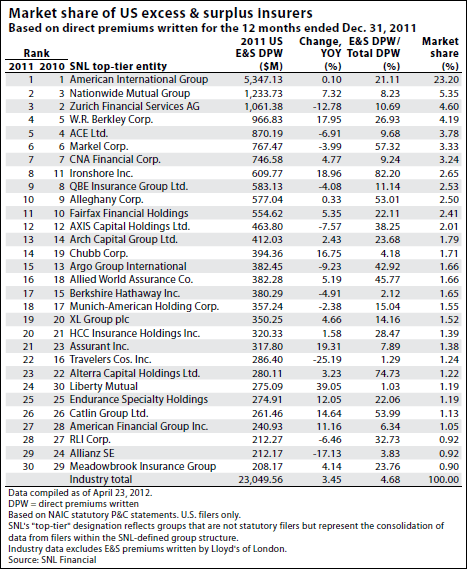
After several years of declines, the U.S. excess and surplus market saw an increase in the overall amount of direct premiums written in 2011, a review of SNL insurance data finds.
The undisputed heavyweight in the space, American International Group Inc., logged a relatively meager 0.1% growth in direct premiums written, but it was nevertheless positive. In 2010, by contrast, AIG saw a 13% drop versus the year prior.
Along with the premium growth, some within the industry have been expressing reasons for optimism, including RLI Corp.’s president and chief operating officer, Michael Stone. Describing E&S casualty as a “real bright spot,” Stone said during an April 19 conference call that rates on umbrella policies for contractors are up sharply in parts of the country, particularly the Northeast, according to a transcript of his remarks.
While RLI’s direct premiums written were down year over year, it was not as dramatic a decrease as that of carriers like Travelers Cos. Inc., a situation not lost on Stone. In response to a question as to whether standard lines carriers have continued to “give some respect” to the E&S market, Stone replied that he is “certainly … seeing them pull back a bit.”
According to SNL data, Travelers’ companies went from writing $130.3 million in direct U.S. E&S premiums in the second quarter of 2010 to only $92.7 million in the second quarter of 2011. That then dwindled to $66.6 million in the third quarter of 2011, and only $57.8 million in the fourth quarter of 2011.
Like RLI, Markel Corp. has a favorable view of current conditions. “We are seeing a market change,” said John Latham, who serves as president of Markel’s wholesale division, in an interview with SNL. He too has witnessed some price increases and believes this trend could continue, as insurers struggle with flagging investment income and potentially overstated capital.
These forces have been somewhat tempered, however, by the admittedly bleak U.S. economic picture. In addition to thinking about one’s bottom line, an insurer must focus on the consumer’s ability to absorb price increases, said Latham.
Amid this environment, some companies have been retooling their product lines. For instance, Alterra Capital Holdings Ltd. announced the sale of its contract binding authority division to Selective Insurance Group Inc. in summer 2011. The CBA business — which Alterra E&S had been running off prior to the sale — was the primary factor behind the roughly $1.3 million in unfavorable development Alterra E&S racked up in 2011 on prior-year estimates, as disclosed in its 2011 annual statement with the NAIC. That $1.3 million represented approximately 5.1% of the company’s prior-year reserves for unpaid losses and loss adjustment expenses.
Selective soon followed that deal up with a similar transaction. In September 2011, the Branchville, N.J.-based insurer announced it would be acquiring Montpelier U.S. Insurance Co. from Montpelier Re Holdings Ltd., in an effort to continue growing its E&S capabilities. “This acquisition includes an end-to-end information technology solution and financial reporting infrastructure that helps build the foundation we need to grow our contract binding authority business,” said Chairman, President and CEO Gregory Murphy in the Sept. 20, 2011, release announcing the deal.
The E&S data can also shed light on new entrants, such as AmTrust Financial Services Inc. Whereas in 2010 none of the company’s subsidiaries reported E&S premiums, in 2011 two of them did. Its Associated Industries Insurance Co. Inc. unit wrote about $5.4 million in E&S premiums in 2011, with 90% coming from California. Meanwhile, its Security National Insurance Co. (TX) unit wrote $3.6 million, with $1.3 million coming from Florida and $2.3 million from Louisiana.
Source: SNL Financial
Was this article valuable?
Here are more articles you may enjoy.

 Flooding in California Leads to Soaked Roads, Water Rescues and 1 Death
Flooding in California Leads to Soaked Roads, Water Rescues and 1 Death  Trump Sues BBC for $10 Billion Over Documentary Edit
Trump Sues BBC for $10 Billion Over Documentary Edit  Twice Injured Firefighter Loses Second Workers’ Compensation Claim
Twice Injured Firefighter Loses Second Workers’ Compensation Claim  Jump Trading Faces $4 Billion Terraform Administrator Suit
Jump Trading Faces $4 Billion Terraform Administrator Suit 